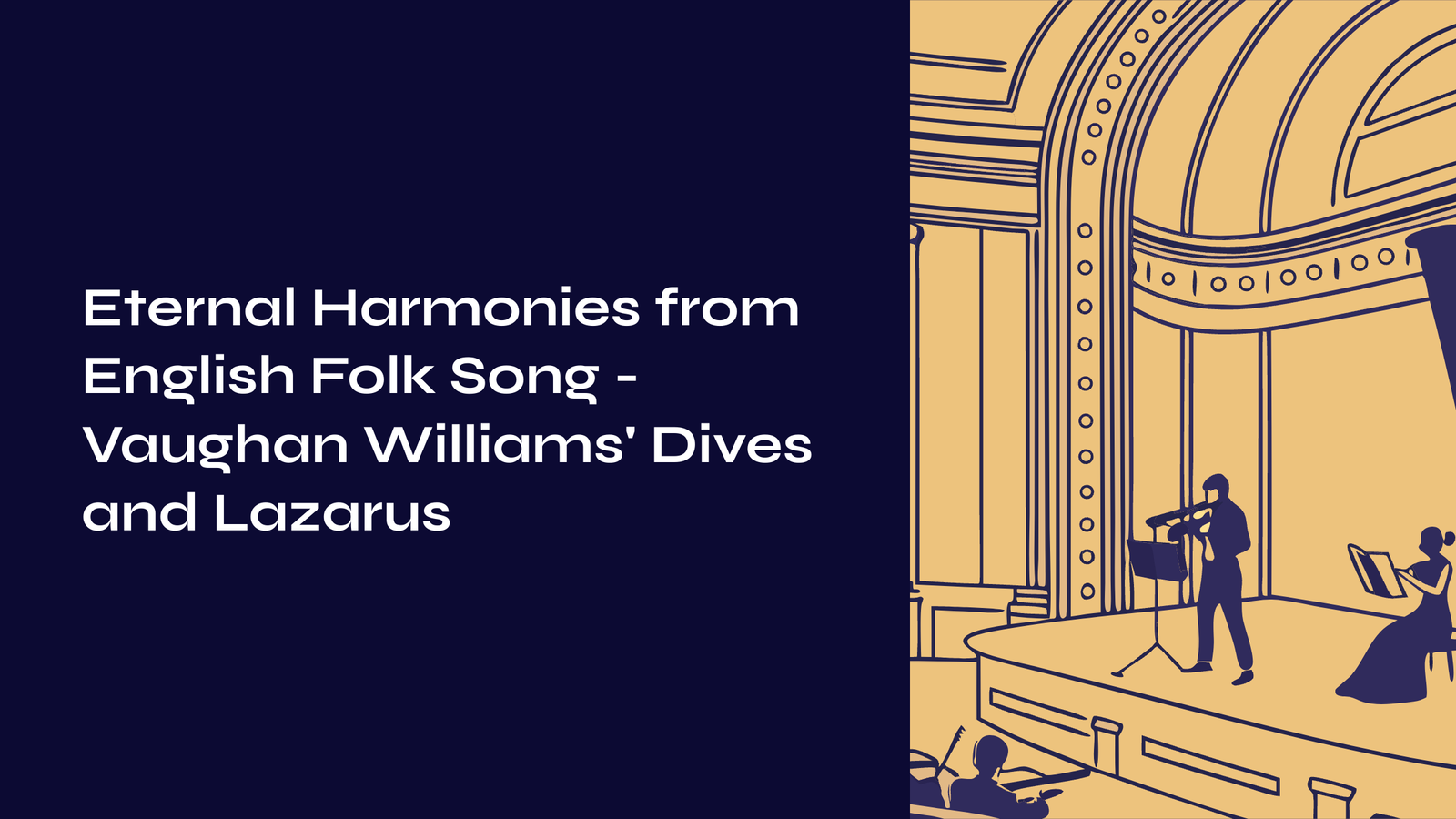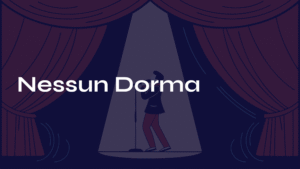Table of Contents

A melody rising from memory’s depths
Some music strikes us like an ancient memory from the very first hearing. Like a grandmother’s lullaby from childhood, or a story someone once sang to us long ago. Ralph Vaughan Williams’ “Five Variants of Dives and Lazarus” is precisely such music.
On that sweltering summer night in 1939 at the New York World’s Fair, when this melody first echoed through Carnegie Hall, it began as a simple English folk song but found new life within the deep harmonies of strings. The composer himself confessed to feeling “that sense of recognition—here’s something which I have known all my life, only I didn’t know it!” That moment of profound connection still resonates with us today.

From folk song collector to composer – A journey across time
The man who unlocked England’s musical treasure chest
Ralph Vaughan Williams was far more than a composer. For eleven years, from 1903 to 1914, he traveled across 21 English counties, collecting over 800 folk songs. This was no mere hobby, but a scholar’s passionate mission to preserve England’s vanishing musical heritage.
From the moment he recorded his first folk song, “Bushes and Briars,” from 70-year-old Essex laborer Charles Pottipher, Vaughan Williams discovered the true beauty of English folk tradition. Among all these treasures, “Dives and Lazarus” held special significance. That fateful encounter with the melody in either 1893 or 1898 would, four decades later, give birth to this masterpiece.
The 1939 New York World’s Fair and British cultural diplomacy
The 1939 New York World’s Fair, themed “Building the World of Tomorrow,” was an international cultural celebration. The British Council seized this opportunity to showcase contemporary British music to the world, commissioning Vaughan Williams for this very purpose.
The premiere on June 10th at Carnegie Hall was a historic moment. On that sweltering summer day, without air conditioning, audiences fanned themselves with program booklets while listening to the New York Philharmonic under Adrian Boult’s baton. In that moment, an ancient English folk song found new life on American soil.

From scripture to folk song, from folk song to string orchestra
Dives and Lazarus – An eternal story
The story underlying this work comes from the parable of the rich man and Lazarus in Luke 16 of the New Testament. The wealthy Dives, living in luxury, ignored the beggar Lazarus at his gate, and upon death, they met opposite fates in heaven and hell.
This biblical tale transformed into English balladry as early as 1557. In the folk version, when Dives refuses bread to Lazarus and orders his servants to whip him, the servants find themselves unable to strike, and the dogs lick Lazarus’s wounds instead. Vaughan Williams reimagined this melody, enriched with such folk interpretation, in his own musical language.
The magic of string orchestra – Divisi and harp in dialogue
The work is scored for string orchestra and harp. Vaughan Williams employs sophisticated divisi techniques, creating rich harmonic textures reminiscent of layered choral harmonies. His precise instructions for “Viola Desks 1, 3, 6” and “Viola Desks 2, 4, 5” represent innovations in timbre that transcend simple string orchestration.
The harp serves not merely as accompaniment but as an equal partner in dialogue. When the strings sing the theme, the harp provides commentary like an ancient bard’s lyre, sometimes offering harmonic support, sometimes delivering celestial consolation.

The emotional spectrum blooming through five variants
Introduction and Theme – The profound resonance of Adagio
The work opens in B modal minor. The theme presented in the introduction is simple yet carries deep resonance—the essential beauty of a melody passed down through centuries of English folk tradition. The way the strings take up this theme in succession resembles villagers gathered in a circle, sharing stories.
Variant I – The triple-time dance of harp and strings
In the first variant, the music transforms into a 3/4 dance. The strings singing above the harp’s arpeggios evoke folk dancing in spring meadows. Here, the music transcends its sorrowful story to celebrate life’s joy.
Variant II – The dynamism of Allegro moderato
The second variant unfolds at a brisker pace. The theme, sketched in three-bar phrases, creates tension like urgent news being delivered. This might express the dramatic tension of the moment when the contrasting fates of Dives and Lazarus are determined.
Variant III – The lyrical confession of solo violin
The third variant shifts to D modal minor, with solo violin and harp singing the theme together. This is the work’s most personal and lyrical moment, creating an intimacy as if Lazarus himself were telling his story directly.
Variant IV – The stately 2/4 march
The fourth variant unfolds as a dignified march in 2/4 time. This moment demonstrates the nobility of English folk song—not mere peasant melody, but something approaching the sublimity of a hymn containing universal truth.
Variant V – The return to origins in Adagio
In the final variant, the music returns to the original B modal minor and Adagio tempo. But this is no simple repetition—it’s a mature restatement of the theme, enriched by the emotional depth accumulated through five variants. The cello solo, gentle resolution in the strings, and the harp’s rising arpeggios create a moment of ultimate musical perfection.

Eternal truths discovered in folk song
The mystique of modal harmony
Vaughan Williams’ use of modal harmony in this work represents a philosophical choice beyond mere compositional technique. Rather than the definitive emotions of major or minor keys, modality creates an atmosphere both ambiguous and mystical—a modern reinterpretation of folk song’s primitive purity.
The journey from B modal minor to D modal minor and back again musically expresses the cycle of human existence. The perpetual circulation of wealth and poverty, life and death, despair and redemption—the very pattern of human life drawn in musical terms.
The perfection of English pastoralism
This work represents the mature flowering of Vaughan Williams’ distinctly English pastoralism. Composed during the same period as his Symphony No. 5 (1938-1943), it shows his evolution from the harsh dissonances of the Fourth Symphony toward a more peaceful, modal style.
The work also connects deeply with his opera “The Pilgrim’s Progress.” The spiritual journey of Dives and Lazarus mirrors the Christian pilgrimage in Bunyan’s allegory. The passage from earthly suffering to eternal salvation was the musical theme Vaughan Williams pursued throughout his life.

Keys to deeper listening
Focus on divisi techniques
When listening to this work, pay special attention to the string divisi techniques. Notice the subtle timbral changes created by playing the same melody on different strings or dividing the same section into multiple groups. This provides a coloristic richness impossible with simple string orchestration.
Follow the harp’s role
The harp is not merely accompaniment but an equal dialogue partner with the strings. Listen carefully to how the harp intervenes in each variant—sometimes providing harmonic support, sometimes offering decorative commentary.
Read the meaning in tempo changes
The structure—beginning with slow introduction, developing through various tempos, and returning to slow conclusion—carries meaning beyond simple musical form. This expresses life’s journey in musical terms. Feel the emotional message the composer conveys through each variant’s tempo and character changes.

The power of music beyond time
Listening to this work, one loses all sense of time. A melody that began in 16th-century English folk song, reborn through 20th-century string orchestra, still moves our hearts in the 21st century.
It was no coincidence that this work, premiered at the 1939 New York World’s Fair, was performed again at Westminster Abbey for the composer’s funeral in 1958. This was proof of the very eternality Vaughan Williams sought through his music.
The story of Dives and Lazarus is not merely a biblical parable but an eternal human tale of justice, compassion, and redemption. By reinterpreting this ancient story through modern string orchestra, Vaughan Williams built a musical bridge connecting past, present, and future.
When the music ends and the harp’s final arpeggios fade away, we realize we have encountered not just a beautiful story, but the fundamental questions of human existence. This is the power of true art—that mysterious ability to speak directly to our souls across time.

Next destination – Shostakovich’s Waltz No. 2
Leaving the mystical world of English folk song, let us journey to the ballrooms of Soviet Russia. Dmitri Shostakovich’s Waltz No. 2 presents a completely different world from Vaughan Williams’ pastoral lyricism.
Composed in 1938, this work contains the complex inner life of a composer forced to live under Stalin’s regime. Superficially sweet and romantic, the waltz harbors forced smiles and suppressed sorrows beneath its surface. Discover the irony hidden behind the orchestra’s brilliant sonorities.
Though lasting barely three minutes, the piece perfectly balances Shostakovich’s characteristic satire and melancholy. Where Vaughan Williams drew inspiration from ancient English tradition, Shostakovich musically depicted the contradictory reality of the Soviet era. Comparing these two composers’ different approaches offers fascinating listening insights.
From the purity of English folk song to the elegant hypocrisy of Russian waltz, the emotional spectrum that classical music can embrace is truly infinite.



